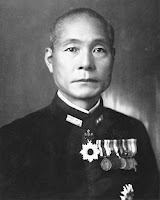A SUPERIOR FORCE OF ARMSOn 2nd March 1943 the Battle of the Bismark Sea took place in the South West Pacific area during World War II. Aircraft of the United States Fifth Air Force and the Royal Australian Air Force attacked Japanese convoy that was carrying troops to Lae in New Guinea. The Japanese suffered heavy losses. A couple of News-reels from US and UK News services reported the action. The battle lasted two days.
Ennis Whitehead………..……………...Joe Hewitt
The American and Australian forces were commanded by Lieutenant General Ennis C Whitehead and Air Commodore Joe Hewitt. They had at their disposal 39 heavy bombers, 41 medium bombers, 34 light bombers and 54 fighters. The Japanese convoy consisting of 8 destroyers, 8 troop transports and 100 aircraft was under the command of Admiral Masatomi Kimura and Vice Admiral Gunichi Mikawa.
Kimura……………...…..Mikawa
The reported losses for the Allied forces were 2 Bombers, 4 Fighters and 8 killed. For the Japanese, all 8 troop transports, 4 destroyers sunk, 20 fighters destroyed and 2890 killed.
The news footage is extremely jingoistic, so much so as to make one cringe now, but it was not unexpected at the time. With an average of 7 allied bombers per Japanese ship, the losses are not exactly surprising, but they are discomforting at a ratio of over 360 to 1.
The ferocity of air power cannot be underestimated. One wonders at the situation in Libya vis a vis the rebels. It is reported that:
The Libyan Air Force was created after the U.S. and UK pressured then-ruling King Idris to modernise his armed forces so that they could better stand off against revolutionary regimes in the Middle East. The LAF was created in 1963. The Libyan Air Force had an estimated personnel strength of 22,000 in 2005(?). There are 13 military airbases in Libya.
After U.S. forces had left Libya in 1970, Wheelus Air Base, a previous U.S. facility about seven miles from Tripoli, became a Libyan Air Force installation and was renamed Okba Ben Nafi Air Base. OBN AB housed the LPAF's headquarters and a large share of its major training facilities. LPAF Soviet-made Mikoyan-Gurevich MiG-17, Mikoyan-Gurevich MiG-19, and Mikoyan-Gurevich MiG-25 fighters and Tu-22 bombers were based at Okba Ben Nafi Air Base.
Clearly the U.K. and the U.S. do not appear to have thought much about strategic forward planning over the possibility of selling weapons. It would seem, given the details of types of aircraft, the USSR did better in that department. None the less, what next?




No comments:
Post a Comment